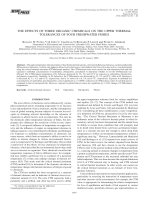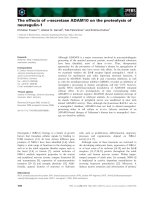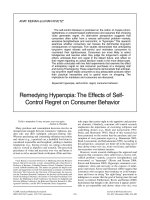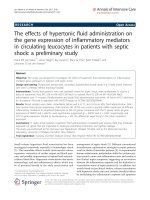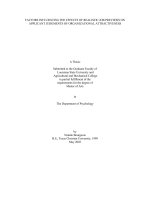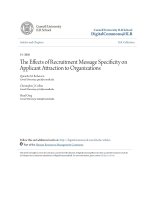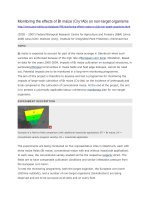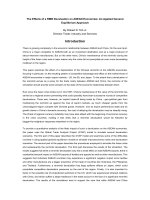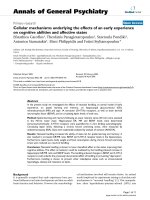THE EFFECTS OF TESTTAKING STRATEGY INSTRUCTIONS ON REDUCING STUDENTS’ TEST ANXIETY AND IMPROVING TEST RESULTS HIGH SCHOOL
Bạn đang xem bản rút gọn của tài liệu. Xem và tải ngay bản đầy đủ của tài liệu tại đây (324.85 KB, 60 trang )
Ministry of Education and Training
Hanoi University
THE EFFECTS OF TEST-TAKING STRATEGY
INSTRUCTIONS ON REDUCING STUDENTS’ TEST
ANXIETY AND IMPROVING TEST RESULTS HIGH
SCHOOL
Submitted in partial fulfillment of the
requirement of the degree
of master of art in TESOL
Hanoi
August 2015
Ministry of Education and Training
Hanoi University
THE EFFECTS OF TEST-TAKING STRATEGY
INSTRUCTIONS ON REDUCING STUDENTS’ TEST
ANXIETY AND IMPROVING TEST RESULTS AT
HIGH SCHOOL
Submitted in partial fulfilment of the
requirement of the degree
of master of art in TESOL
Supervisor:
Hanoi
August 2015
1
TABLE OF CONTENTS
ACKNOWLEDGEMENTS..................................................................................................iii
ABSTRACT...........................................................................................................................iv
LIST OF ABBREVIATIONS.................................................................................................v
LIST OF TABLES.................................................................................................................vi
LIST OF FIGURES.............................................................................................................viii
CHAPTER 1: INTRODUCTION..........................................................................................1
1.1.Background to the study..................................................................................................1
1.2.Aims of the study............................................................................................................4
1.3. Scope of the study..........................................................................................................4
1.4. Significance of the study................................................................................................5
1.5. Outline of the thesis.......................................................................................................5
CHAPTER 2: LITERATURE REVIEW..............................................................................7
2.1. Fundamental premise of test anxiety .............................................................................7
2.2. Language learning strategies..........................................................................................8
2.3. Fundamental premise of test-taking strategies..............................................................10
2.4. Research on test anxiety ..............................................................................................12
2.5. Gaps in the existing literature.......................................................................................19
2.6. Summary......................................................................................................................20
CHAPTER 3: METHODOLOGY.......................................................................................21
3.1. Research questions.......................................................................................................21
3.2. Subjects........................................................................................................................21
3.3. Variables......................................................................................................................22
3.4. Data collection instruments..........................................................................................22
3.5. Data collection procedures...........................................................................................25
3.6. Data analysis................................................................................................................27
3.7. Treatment: Test-taking strategy ...................................................................................28
CHAPTER 4: RESULTS AND DISCUSSION...................................................................35
4.1. Results..........................................................................................................................36
4.2. Discussion....................................................................................................................47
CHAPTER 5: IMPLICATIONS AND CONCLUSION.....................................................49
5.1. Implications.................................................................................................................49
5.2. Further research and limitations...................................................................................50
5.3. Conclusion...................................................................................................................50
APPENDIXES
ii
ACKNOWLEDGEMENTS
I would like to express my most sincere appreciation to my supervisor, Hoang Thi
Xuan Hoa, Ph.D. for her encouragement and guidance throughout the research.
Without her well-designed plan and meticulous review of the draft, this study would
have been impossible.
I also wish to thank all the staff members of Post-graduate Department of Hanoi
University for giving me the best environment to fulfill my thesis.
I would like to acknowledge and express my appreciation to my colleagues from
Duong Xa High School for their enthusiastic supports and constructive suggestions in
completing this research.
My special thanks also go to the students at Duong Xa High School who have helped
me to collect data for this study.
Finally, my gratitude is extended to my family for their endless love, constant support
and encouragement.
iii
ABSTRACT
The objective of the study is to examine the effects of test-taking strategy instructions
on reducing Duong Xa High School students’ test anxiety and as a result improving
their test results.
To achieve the objective of the study, the writer conducted a quasi-experimental
research. The subjects were 96 students in grade 11 with the age of 16-17. The two
intact groups were assigned to the experimental and control groups. Both groups did
the same tests, but there was a difference: while the experimental group had testtaking strategy instructions, the control group did not.
All participants took proficient pre- and post-tests, as well as the Westside Test
Anxiety Scale was used to scale their test anxiety level. The two groups also wrote
self-reports to describe their attitude towards using test-taking strategies. The results
show that test-taking strategy instructions helped the experimental group to reduce the
students’ test anxiety and improved their test results, and the control group showed
their eager to learn test-taking strategies.
Based on the findings of the study, some discussion and implications were made
along with recommended suggestions for further research.
iv
LIST OF ABBREVIATIONS
-
GCSE : General Certificate of Secondary Education
-
FLAS: A foreign language anxiety scale
-
FNE: a scale for fear of negative evaluation
-
EFL: English as foreign language
- L2: second language
-
WTAS: The Westside test anxiety scale
-
RQ: research questions
-
M: Mean
-
SD: Standard Deviation
-
ESL: English as a second language
-
LLS: Language learning strategy
-
LLSI: Language learning strategy instruction
-
LLSs: Language learning strategies
-
L1: First language
-
L2: Second language
-
P: Probability value
v
LIST OF TABLES
Table
3.1:
The
study
schedule
......................................................................................................................................
26
Table
3.2:
Teaching
strategy
procedure
......................................................................................................................................
35
Table 4.1: Statistics of Pre- and Post-test of the Experimental Group and the Control
Group
......................................................................................................................................
38
Table 4.2: Paired Samples T-Test for Pre- and Post-test of the Experimental Group
and
the
Control
Group
......................................................................................................................................
39
Table 4.3: Independent Samples T-Test for the Experimental Group and the Control
Group
......................................................................................................................................
40
Table 4.4: The number of the students with 1.0 - 1.9 comfortably low test anxiety and
4.0
5.0
extremely
high
anxiety
......................................................................................................................................
41
Table 4.5: The number of the students with the test anxiety scale group
......................................................................................................................................
42
Table 4.6: Statistics of tests anxiety level within groups of participants
......................................................................................................................................
42
Table 4.7: Paired Samples T-Test for Tests anxiety level in Pre- and Post-test of the
Experimental
Group
and
the
Control
Group
......................................................................................................................................
44
Table 4.8: Independent Samples T-Test for Tests anxiety level between the
Experimental
Group
and
the
Control
Group
vi
......................................................................................................................................
45
vii
LIST OF FIGURES
Figure 4.1 Statistics of Pre- and Post-test of the Experimental Group and the Control
Group
......................................................................................................................................
38
Figure
4.2
Test
results
between
the
two
groups
......................................................................................................................................
40
Figure 4.3: Statistics of tests anxiety level within groups of participants
......................................................................................................................................
43
Figure 4.4: Statistics of tests anxiety level between the Experimental Group and
Control
Group
......................................................................................................................................
45
viii
CHAPTER 1: INTRODUCTION
1.1. Background to the study
1.1.1. Practical Perspective
Tests have become a powerful tool for decision making in our competitive society, with
individuals of all ages being frequently evaluated with respect to their achievement and
abilities. Consequently, how to perform better on tests has become a prime concern for
students and teachers in almost all areas.
Testing is also one of the primary causes of stress among students. One reason for this is
inaccurate conceptions of what to expect on a test and how to prepare for an exam. In
addition, many tests are less than perfect and do not always give an accurate assessment
of student ability. Despite this, exams will probably continue to be the main method of
student evaluation because they are relatively efficient and objective measures of
student performance.
Duong Xa High School, which was built in the year of 1971, is located in Gia Lam
District of Hanoi. There are 37 classes (grade 10, 11, and 12) with approximate 1,800
students. The students have to pass an entrance examination to be in school. Most
students in Duong Xa High School come from farming families and they cycle about 5
or 10 kilometers to school everyday. English is one of compulsory subjects and it has
become a core subject of important examinations including the GCSE (General
Certificate of Secondary Education) examination.
The students at Duong Xa High School often reveal that when taking tests, they are too
nervous to recall the knowledge and they become confused. In spite of the fact that the
students show their good understanding and good ability during the English lessons,
their test results are often lower than they and their teachers expect. Then, their parents,
their teachers and their friends’ negative attitudes towards that low result make them
become more worried before every test. Besides the fear of negative evaluation, the
students also reveal that many of them lack of test-taking skills. As a result, they are
1
disappointed with themselves and do not believe in their capacity, which brings about
negative effects on the interest and motivation in learning English.
A part from the high school entrance examination that the students passed, every high
school student would be facing with other important examinations such as final
semester examinations, the GCSE examination, and university entrance examination.
Therefore, it is necessary and worth conducting a research at Duong Xa High School on
how to help students overcome test anxiety and as a result improve their test scores.
1.1.2. Theoretical Perspective
The related literature on test anxiety in language learning point out that the factors that
influence students’ reactions to language tests are perceptions of test validity, time limit,
test techniques, test format, length, testing environment and clarity of test instructions
(Young, 1991). In addition, the researchers show that learners’ capacity, task difficulty,
the fear of getting bad grades and lack of preparation for the test are other factors that
make test takers worried. Similarly, learners with high levels of anxiety have less
control of attention (Sarason, 1980, 1986). According to Chastain (1975), there was a
negative correlation indicating that low test anxiety was related to greater success. Last
of all, in Ohata’s study (2005) most of the participants said that they feared taking tests
because test-taking situation would make them fearful about the negative consequences
of getting bad grade. One form of test anxiety results from such things as poor study
habits, inadequate organizational skills, in-effective time management.
Test anxiety becomes problematic when this nervousness is so high that it interferes
with test preparation and performance. Test anxiety produces bad results, which makes
students feel unconfident because the tests do not accurately measure their abilities. Test
anxiety is a major factor contributing to a variety of negative outcomes including
psychological distress, academic underachievement, academic failure, and insecurity
(Hembree, 1988). Many students have the cognitive ability to do well on exams but may
not do so because of high levels of test anxiety. Because of the societal emphasis placed
on testing, this could potentially limit their educational and vocational opportunities
(Zeidner, 1998).
2
When preparing for a test, previous research indicates that when students have tools and
strategies that build both emotional skills and healthy physical habits they can overcome
test anxiety and the associated symptoms. As a result, they improve their ability to
prepare for and perform on exams. The most frequently mentioned strategies address
the following areas:
•
Relaxation
•
Knowledge of testing conditions
•
Adequate preparation through improvement of test-taking and study skills
•
Effective health habits, exercise, and good nutrition
•
Monitoring of thinking patterns and positive self-talk
Eight steps have been identified to reduce exam anxiety
•
Effective studying
•
Healthy lifestyle
•
Accurate information
•
Exam-taking preparation
•
Attitude upgrading
•
Rational (instead of irrational) thinking
•
Test-taking strategies
•
Anxiety reduction techniques
Previous research indicates that teachers can implement effective strategies to assist
test-anxious students. By being aware of the types of student with these traits, they can
develop, modify, and implement various strategies into their teaching repertoires.
Furthermore, teachers who employ formative factors, habitual prudence, purposeful
learning experiences, and test-wise guidelines can help students with their academic
performance levels while significantly diminishing their levels of test anxiety.
With the increase of testing in schools, teachers need to recognize the role test anxiety
plays in student performance and then implement effective strategies to assist students
who are overshadowed this trait. Teachers are responsible to enhance and measure
student learning within their classrooms; they are also responsible to prepare students
for testing.
3
Based on all the reasons discussed above, test-taking strategy plays a very important
part in reducing students’ test anxiety. Therefore, it is very necessary to carry out a
study on how to improve students’ testing skills to reduce their test anxiety and to
improve the test results at Duong Xa High School.
1.2. Aims of the study
The present study’s aim is to examine the effects of the test-taking strategy instructions
of multiple-choice tests in the test room on reducing Duong Xa High School students’
test anxiety and as a result improving their test results.
The study investigated whether improving the students with test-taking strategies would
help them less nervous when taking tests. The correlation between the participants’ test
anxiety level and their test results was examined. The present study also reported the
students’ opinions about the benefits of test-taking strategy instructions to their test
anxiety English test results.
To achieve these aims and objectives , the study provides the answers to the two
following research questions:
Are there any significant differences between students who receive testtaking strategy instructions and those who do not in terms of their test
anxiety level and test results?
What are the participants’ opinions of test-taking strategy instructions used
to reduce their test anxiety and improve the test results?
1.3. Scope of the study
A quasi-experimental study was designed to examine the effects of test-taking strategy
instructions on reducing students’ test anxiety and as a result improving their English
test results. The test-taking strategy instructions was strategies of multiple choice tests
in the test room. 96 students of grade 11 at Duong Xa High School were the participants
of the study. The findings obtained from this study was to help improve teaching and
learning test-taking strategies, which encourages students at Duong Xa High School to
be more confident before, during and after taking tests and to get best results.
4
1.4. Significance of the study
The results of the study may have some impacts. Firstly, teachers may be more aware
of the usefulness of test-taking strategies for their students. Therefore, they will spend
more time and effort to teach students test-taking strategy instructions effectively and
they even find out other good ways to reduce their students’ test anxiety level and
improve the test results. On the other hand, students may get some certain benefits from
the study. They may be more confident to overcome test anxiety and have best results,
which reflect accurately their capacity. As a result, they become more interested in
learning English. They are also likely to ready to face with every coming important
examination.
1.5. Outline of the thesis
The thesis is divided into five chapters below:
Chapter 1: Introduction, presents the background to the study, states the aims of the
study, scope of the study and significance of the study. The outline of the study is also
discussed.
Chapter 2: Literature review, deals with the brief review of the previous studies relating
to test anxiety including the researchers’ findings on the issues. The first section
provides the fundamental premise of test anxiety, language leraning strategies and testtaking strategies. The second section discusses the studies on test anxiety. The third
section concerns the gaps in the existing literature.
Chapter 3: Methodology focuses on the research method used to gather and analyze
data. First, research questions are addressed. Then instruments for data collection,
subjects and procedures are described. The chapter ends with data analysis and
summary.
Chapter 4: Results and discussion, reports the results of the effects of test-taking
strategy instructions on reducing the students’ test anxiety level and as a result
improving their test result at Duong Xa High School.
5
The major findings are considered as basic for some suggestions for future pedagogical
implications.
Chapter 5: Implications and Conclusion, provides several implications and conclusion
for Duong Xa High School to have some trainings for students, mentions some
limitations of the present research and suggestions on further studies.
6
CHAPTER 2: LITERATURE REVIEW
This chapter deals with the brief review of the previous studies relating to test anxiety
including the researchers’ findings on the issues. The first section provides the
fundamental premise of test anxiety, language leraning strategies and test-taking
strategies. The second section discusses the studies on test anxiety. The third section
concerns the gaps in the existing literature.
2.1. Fundamental premise of test anxiety
2.1.1. Definition of Test anxiety
Anxiety is described as an uncomfortable emotional state in which one perceives
danger, feels powerless and experiences tension in preparation for an expected danger
(Blau, 1995). Language anxiety is an effective factor that affects achievement in second
language (L2) (Gardner, 1985). Depending on the synthesis of research context on L2
anxiety, Gardner and MacIntyre (1993) describes it as the apprehension experienced
when a situation requires the use of L2 with which the individual is not fully proficient.
Thus, L2 anxiety is described as a situation-specific anxiety. It has three varieties:
communicative apprehension, fear of negative evaluation, and test anxiety.
Test anxiety is an apprehension over academic evaluation. It is a fear of failing in test
situations and an unpleasant experience held consciously or unconsciously by learners
in many situations. It is a type of anxiety concerning apprehension over academic
evaluation which comes from a fear of failure (Horwitz & Young, 1991).
2.1.2. Characteristics of Test anxiety
Test anxiety is composed of three major components: cognitive, affective, and
behavioral. Students who experience test anxiety from the cognitive perspective are
worriers lacking self confidence. They may be preoccupied with negative thoughts,
doubting their academic ability and intellectual competence (Sarason, 1990).
7
Furthermore, they are more likely to overemphasize the potential negative results and
feel helpless when in testing situations (Zeidner, 1998). Some students may feel the
need to answer every question on the test correctly. When this does not occur they may
think of themselves as being incompetent, thus fueling negative thoughts such as, "I
knew I was not going to pass this test," "I know I am going to make a poor grade," or
"Everyone knows I am not smart." In order for students to have the best opportunity for
academic success, negative thinking must be minimized and controlled.
From the affective perspective, test anxiety causes some students to experience
physiological reactions such as increased heart rate, feeling nauseated, frequent
urination, increased perspiration, cold hands, dry mouth, and muscle spasms (Zeidner,
1998). These reactions may be present before, during, and even after the test is
completed. In conjunction with the physiological reactions, emotions such as worry,
fear of failure, and panic may be present. When students are not able to control their
emotions, they may experience higher levels of stress, thereby making it more difficult
for them to concentrate.
Test-anxious students express anxiety behaviorally by procrastinating and having
inefficient study and test-taking skills. Zeidner (1998) contends that test-anxious
students have a more difficult time interpreting information and organizing it into larger
patterns of meaning. In addition, some students may physically feel tired or exhausted
during test administration because they do not have a healthy diet, have poor sleeping
habits, and fail to routinely exercise.
2.2. Language learning strategies
According to Griffiths (2004), the concept of ‘strategy’ appears to be a little difficult to
define in a way that generates widespread agreement among scholars. In fact, within
second and foreign language education, LLSs have been defined in various ways (Bull
& Yingxin, 2001).
One of the earliest researchers in this field, Rubin (1975) provided a very broad
definition of learning strategies as ‘the techniques or devices, which a learner may use
to acquire knowledge’. Then, in a later study, Rubin (1987) also pointed, ‘LLSs are
8
strategies which contribute to the development of the language system which the learner
constructs and affects learning directly’ (p.23).
More specifically, Chamot (1999) defined LLSs as “techniques, approaches or
deliberate actions that students take in order to facilitate the learning and recall of both
linguistic and content area information”.
Chamot and O’Malley (1993) offered another definition of LLSs as ‘the special
thoughts or behaviors that individuals use to help them comprehend, learn, or retain new
information’ (p.1)
Oxford (1990) argues that the definition commonly used does not fully convey the
excitement or richness of learning strategies and expands the definition by saying
‘learning strategies are specific actions taken by the learner to make learning easier,
faster, more enjoyable, more self-directed, more effective and more transferable to new
situations’ (p.8). Obviously, Oxford’s definition is even more specific than others’.
According to this definition, LLSs are specific actions, behaviors, steps or techniques
that learners use in order to help the result of their learning in inputting, comprehending
and outputting the target language. She believes that appropriate LLSs could help
learners gain self-confidence and improve proficiency.
Therefore, although LLSs have been defined in various ways, they have been broadly
defined as ‘specific actions or techniques that students use, often intentionally, to
improve their progress in developing L2 skills’ (Lee, 2003). It is likely to suggest that
the definition proposed by Oxford (1990) can provide a useful base for understanding
LLSs and for launching research (Griffiths, 2004). Obviously, the best way to
understand what is meant by learning strategies is to look at the major functions of a
typical classification of such strategies which will be presented in the next section of
this chapter.
9
2.3. Fundamental premise of test-taking strategies
2.3.1. Definition of Test-taking strategies
Test-taking strategies originated from the concept of ‘test-wiseness’ which is defined as
“one’s capacity for using test characteristics and formats and/or test-taking situations to
raise test scores” (Millman et al., 1965, cited in Ritter & Idol-Maestas, 1986, p. 50).
According to Cohen (2000), language test-taking strategies consisted of both language
use strategies and test-wiseness strategies. He further defined them as those test-taking
processes that the candidates have selected and they are conscious of to a certain degree
(Cohen & Upton, 2006).
Jimenez et al. (1996) referred to test-taking strategies as operations or steps used by
test-takers to facilitate the retrieval of information and classified them into four
groups-reader-initiated strategies, text- initiated strategies, bilingual strategies and
interactive strategies. Deanna (2002) believed that cognitive and meta-cognitive
strategies were involved in doing reading comprehension tests and that the former could
be grouped into key words, deduction, reasoning and reconstruction; and the latter,
could be categorized into planning, monitoring and evaluation (as Oxford (1990) did).
All the definitions, though worded differently, have in common strategies that are
somehow related to what test takers do and might do to solve test problems. In short, a
strategy is a general plan or set of plans intended to achieve something especially over a
long period. Strategy is the art of planning the best way to gain an advantage or achieve
success. Therefore, in this study’s context, test-taking strategy instructions is understood
as set of plans about taking tests for the students to gain an advantage or achieve
success in term of controlling test anxiety level and obtaining their best results.
10
2.3.2. Areas of Test-taking strategies
The test-taking strategies cover the areas below:
•
Before the Test
•
In the Test Room
•
General Strategies
•
Essay Tests
•
Multiple Choice Tests
•
True-False Tests
•
Matching Tests
•
Fill-in and Short Answer Tests
•
Vocabulary Tests
•
Number Problems
•
Take-Home Tests
•
Open-Book Tests
•
Standardized Tests
•
Verbal Analogy Tests
•
Reading Comprehension Tests
•
Identify and Explain Tests
•
Oral Tests
•
After the Test
In all strategies above, strategy of multiple-choice tests in the test room was chosen to
be the treatment for the experimental group in this study.
2.3.3. Benefits of Test-taking strategies
Scruggs & Mastropieri (1992) claimed that students who are test wise can outperform
students of equal ability but lacking test-wiseness. Teaching test-taking strategies helps
students understand the format and conventions of a specific type of test and makes
them feel comfortable in a testing environment. Learning test-taking strategies actually
improves the validity of a test by making scores reflect more accurately what students
know (Scruggs & Mastropieri, 1992). The primary purpose of test-taking strategies is to
improve student performance on exams. A second, but related, purpose is to reduce
11
exam anxiety. If both of these goals are achieved, higher test scores should result.
Kessleman-Turkel and Peterson (2004) supposed that when you take a test - any test
-you are really being tested on two things: how much you know about the subject and
how much you know about taking a test.
2.4. Research on test anxiety
2.4.1. Studies on the causes of students’ test anxiety
Aydin et al. (2008) investigated the teacher effect on the level of test anxiety among
young EFL (English as foreign language) learners. Their subjects were 477 young
learners from 5 primary schools. Data collection instruments consisted of a
questionnaire and Test Anxiety Scale (TAS: Sarason, 1978). They found that the
students who had positive attitudes towards their English teachers felt more confident
and relaxed and less nervous even if they forgot what they knew. Moreover, the
participants who had positive attitudes towards their English teachers were less
embarrassed during examinations, felt less uneasy before getting their exam papers, and
believed more strongly that it was not possible to learn more without examinations. The
findings demonstrate that positive attitude towards EFL teachers decrease the levels of
test anxiety among young EFL learners.
Aydn (2008) had an investigation on the language anxiety and fear of negative
evaluation among Turkish EFL learners to investigate the sources and levels of negative
evaluation as well as language anxiety among Turkish students as EFL learners, and to
determine the correlation between the two. A foreign language anxiety scale (FLAS:
Horwitz et al., 1986) and a scale for fear of negative evaluation (FNE: Leary, 1983)
were administered to a sample group of 112 foreign language learners. The results of
the analysis indicated that EFL learners suffer from language anxiety which is aroused
by factors, such as un-preparedness for class, communication apprehension with
teachers, peers, and native speakers; teachers’ questions and corrections in classroom
environment; tests and negative attitudes towards English course. The sources of fear of
negative evaluation consist of negative judgments by others, leaving unfavorable
impression on others. In addition, fear of negative evaluation is a strong source of
foreign language anxiety. The author also pointed out the limitation in term of the
12
limited subjects and the data collection instruments. He suggested that further study
should focus on the relationship between language anxiety and some other variables as
well as the strategies and tactics to allay language anxiety.
Some researchers examined the test anxiety level of students as EFL learners and
investigated its reasons, effects and results on foreign language learning. For example,
Aydn (2005) found that the learners usually have test anxiety. 114 students in English
Language Department of Necatibey Education Faculty of Balikesir University, Turkey
were the participants of the study. A background questionnaire, Test Anxiety Scale
(Sarason’s, 1984) and a survey were conducted. The result revealed that test anxiety
provoking factors are low level proficiency of the learners, negative attitudes of teachers
towards test applications, students’ attitude towards language learning, test invalidity,
fear of negative evaluation, bad experiences on tests, time limitation and pressure, the
difficulty of course contents and parental expectations. Test anxiety causes physical and
psychological problems, affects motivation, concentration and achievement negatively,
increases errors in learning process, prevents to transfer their real performance to test
results and study efficiently and decrease the interest towards language learning. The
overall results indicate that test anxiety is problematic education area and it can be
coped.
2.4.2. Studies on the relationship between test anxiety and test performance
A study on relationship between language anxiety and proficiency was conducted by
Kondo (2003) to investigate the relationship between language anxiety and proficiency
in English. 1st year students at School of Education, Waseda University were the
participants. This study only found the poor predictor of English proficiency, though
many studies on language anxiety found high correlation between anxiety and language
proficiency. The author suggested that even if that is the case in the context of Japan,
researches in reducing anxiety should be done.
Wu (2007) conducted a research on the relationship between anxiety and reading
comprehension performance in English as a foreign language. A total of 91 first-year
college students studying English as a foreign language from two classes in a private
university in Southern Taiwan participated in the study. The data instrument was the
13
Chinese version of Foreign Language Classroom Anxiety Scale (FLCAS: Horwitz et
al.,1986). The study suggests that students with a higher level of language anxiety tend
to have a higher level of reading anxiety. This relationship is significant and positive.
The finding still suggests that L2 teachers should cope with students’ anxiety in order to
enhance reading comprehension performance and should create a low anxiety classroom
environment in order for students to learn reading.
In Elkhafaifi’s study (2005), listening was explored. Listening comprehension scores
from 233 students of Arabic as a foreign language and the measures of language anxiety
and listening anxiety were analyzed. The results showed that listening anxiety was
positively related to, but distinguished from language anxiety. Students with higher
language anxiety and listening anxiety had lower listening comprehension grades. Mills
et al. (2006) examined the relationship between self-efficacy and language anxiety with
95 university students’ French listening proficiency. They suggested self-efficacy is
defined as personal beliefs in one’s capabilities, and found that the students with low
self-efficacy were more anxious and, in turn, had negative listening achievement.
In term of writing, Abu- Rabia and Argaman (2002) investigated the role of language
anxiety in the English writing achievement of 70 junior high school EFL students. They
found that students with higher language anxiety were inclined to have lower writing
achievement.
Xianping (2003) had a research on language anxiety and its effects on oral performance
in classroom with the subjects of 90 second-year non-English major college students of
XiangFan University. Foreign Language Classroom Anxiety Scale (FLCAS: Horwitz et
al.,1986) and Communication Unit (CU: Phillips, 1992) were used as data instruments.
The result indicates that the degrees of language anxiety among students varied greatly.
Most students seemed to experience mild to severe anxiety. The anxiety about speaking
a foreign language could affect the quality of oral production. It appeared to show that
in general, as the anxiety increases, the quality of oral production decreases.
14
2.4.3. Studies on ways of reducing test anxiety
Larson et al. (2010) tested if relaxation techniques could reduce the negative effects that
self-perceived levels of test anxiety have on third-grade students. Their subjects were
177 third-grade students aged 8-10 years old. The Westside test anxiety scale (WTAS:
Driscoll, 2004), elevator breathing and guided relaxation were utilized to measure and
manage levels of anxiety. The results indicated that the relaxation invention had a
significant effect in reducing test anxiety in the experimental group.
Wachelka D. & Katz R. (1999) conducted a study on reducing test anxiety and
improving academic self-esteem in high school and college students with learning
disabilities. In this study, they used a randomized pretest–posttest control group design
to examine the effectiveness of a cognitive-behavioral treatment for reducing test
anxiety and improving academic self-esteem in a cohort (N=27) of high school and
college students with learning disabilities. All of the students participated voluntarily.
They were enrolled in classes for students with learning problems. Before the study
began, they complained of test anxiety and showed an elevated score on the Test
Anxiety Inventory. Eleven students (85%) completed the 8-week long treatment, which
consisted of progressive muscle relaxation, guided imagery, self-instruction training, as
well as training in study and test-taking skills. Results showed significant improvement
in the treated group which was not evident in an untreated control group (N=16).
Compared to the control group, the treated group showed significant reductions in test
anxiety on the Test Anxiety Inventory, as well as improvement in study skills and
academic self-esteem as measured by the Survey of Study Habits and Attitudes, and the
school scale of the Cooper Smith Self-Esteem Inventory. These results extend the
generality of similar studies on reducing test anxiety and improving academic selfesteem in younger students. They also suggested that relief from test anxiety can be
expected fairly quickly when cognitive-behavioral methods are used.
A research on The Test busters program was carried out by Beidel D. et al (1999). A
pilot program to reduce test anxiety and related social-evaluative concerns was
presented. Test busters was a program designed specifically for elementary and middle
school children in grades 4 through 7 that teaches effective study habits, study skills,
and test-taking strategies and includes a behavioral contract to ensure consistent study
15
behavior. The assessment strategy included self-report instruments, a behavioral
assessment, and children’s grade point averages. After a 6-month waiting period, eight
children with moderate to severe test anxiety participated in the 11-week program. The
results indicated that test busters decreased general levels of test anxiety and self-ratings
of distress when taking a test. Overall grade point average improved significantly and
grades in the majority of the subjects showed positive improvement. There was no
change in overall self-esteem or judgments of cognitive competence. The results were
discussed in terms of the use of a skills strategy to decrease anxiety and improve
academic achievement.
A Meta-Analysis synthesized the results from test anxiety reduction programs, Ergene
(2003). Analyses were based on 56 studies (n = 2,482); the overall mean effect size for
test anxiety reduction programs was 0.65 (95 percent confidence intervals). On
measures of anxiety reduction, the average individual completing treatment was seen as
better off than 74 percent of those individuals who did not receive treatment. The
treatment of test anxiety has been quite successful in reducing the test anxiety level of
clients. The most effective treatments appear to be those that combine skill-focused
approaches with behavior or cognitive approaches. Individually conducted programs,
along with programs that combined individual and group counselling formats, produced
the greatest changes.
Anthony J. & Christine E. (1996) had a study on the relative contributions of
examination-taking coping strategies and study coping strategies to test anxiety: A
concurrent analysis. Both examination-taking coping strategies and study coping
strategies are determinants of test anxiety. This study examines the contributions made
by these two types of coping strategies on the anxiety/performance relationship, under
two types of examination conditions. Twenty-six graduate students, who were enrolled
in an intermediate-level statistics course, were assigned randomly to either an untimed
or a timed examination condition. Both types of coping strategies made a significant
contribution in explaining variance in test anxiety. Overall, students in the timed
condition performed more poorly than did students in the untimed condition. A
significant interaction was found between examination-taking coping strategies and
examination condition: Students with poor coping strategies did not perform as well in
the timed as in the untimed condition. No such interaction was found between study
16

